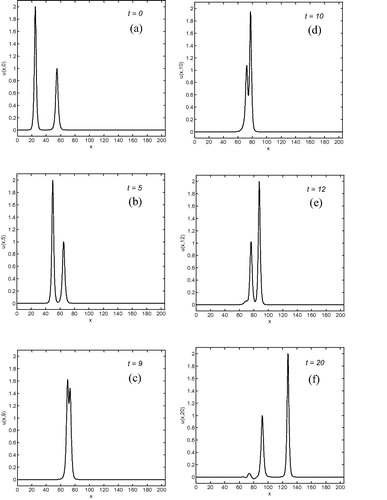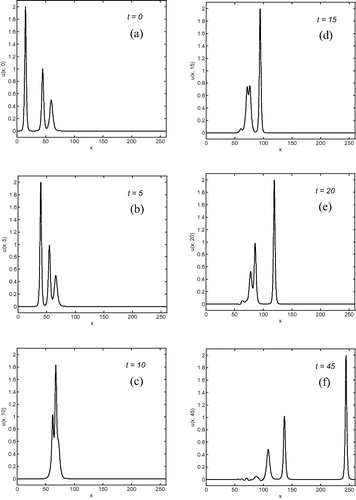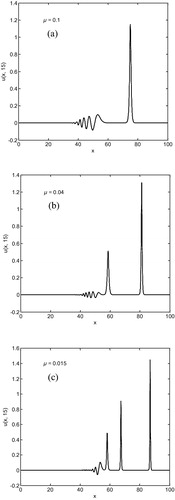Abstract
The modified regularized long wave (MRLW) equation is numerically solved using Fourier spectral collection method. The MRLW equation is discretized in space variable by the Fourier spectral method and Leap-Frog method for time dependence. To validate the efficiency, accuracy and simplicity of the used method, four cases study are solved. The single soliton wave motion, interaction of two solitary waves, interaction of three solitary waves and a Maxwellian initial condition pulse are studied. The and
error norms are computed for the motion of single solitary waves. To determine the conservation properties of the MRLW equation three invariants of motion are evaluated for all test problems.
1 Introduction
The regularized long wave (RLW) equation
(1.1) where
is a positive constant, is a nonlinear evolution equation, which was originally introduced by CitationPeregrine (1966) in describing the behavior of an undular bore and studied later by CitationBenjamin et al. (1972). This equation plays an important role in describing physical phenomena in various disciplines, such as the nonlinear transverse waves in shallow water, ion-acoustic waves in plasma, magneto–hydrodynamics waves in plasma, longitudinal dispersive waves in elastic rods, and pressure waves in liquid’s gas bubbles. Many numerical methods for the RLW equation have been proposed, such as the finite element method, Galerkin method, collocation methods with quadratic B-splines, an explicit multistep method, finite difference methods and Fourier Leap-Frog method (Liu et al., Citation2013; Saka and Dag, Citation2008; Soliman and Raslan, Citation2001; Mei and Chen, Citation2012; Lin et al., Citation2007; Hassan and Saleh, Citation2010). The RLW equation is a special case of the generalized regularized long wave (GRLW) equation
(1.2) where
and
are positive constants and
is a positive integer. Various numerical techniques have been used for the solution of the GRLW equation as (Mohammadi and Mokhtari, Citation2011; Kaya, Citation2004; Roshan, Citation2012; Hammad and El-Azab, Citation2015; Zeybek and Karakoç, Citation2016). The modified regularized long wave equation (MRLW) is a special form of GRLW Eq. Equation(1.2)
(1.2) and it plays a very important role at the modeling of the nonlinear, dispersive media being modeled feature small-amplitude, long-wave length disturbances. The MRLW equation was also solved using various numerical methods such as, a Galerkin finite element method, a spline method, the Adomian decomposition method, a collocation method with cubic B-splines, finite difference scheme, meshless kernel based method of lines, B-spline finite elements, mixed Galerkin finite element methods, Tri-prong scheme, homotopy perturbation method and He’s variational iteration method as Mei et al. (Citation2014), Raslan and EL-Danaf (Citation2010), Raslan and Hassan (Citation2009), Khalifa et al. (Citation2007, Citation2008a,Citationb), Dereli (Citation2012), Gardner et al. (Citation1997), Gao and Mei (Citation2015), Hosseini et al. (Citation2016), Achouri and Omrani (Citation2010), Labidi and Omrani (Citation2011). Discretization using finite differences in time and spectral methods in space has proved to be efficient in solving numerically non-linear partial differential equations (PDE) describing wave propagation. The combined schemes have been applied efficiently to analyze unidirectional solitary wave propagation in one dimension Korteweg de Vries (KdV) equation as Fornberg (Citation1996), Fornberg and Whitham (Citation1987), Hassan and Saleh (Citation2013). The combination of spectral methods and finite differences is applied to the Boussinesq type which admits bidirectional wave propagation as Hassan (Citation2010), Borluk and Muslu (Citation2015). The numerical solution for the modified equal width wave (MEW) equation is presented using Fourier spectral method by CitationHassan (2016). Different analytical and numerical methods are used to solve differential equations as Atangana and Cloot (Citation2013), Atangana (Citation2016), Semary and Hassan (Citation2016), El-Borai et al. (Citation2017). In this study, the combination of Fourier spectral method in space and leap frog in time is applied to the modified regularized long wave equation (MRLW) equation. Consider the MRLW equation
(1.3) where the subscripts x and t denote differentiation, is considered with the boundary conditions
as
. In this study, boundary conditions are chosen from
(1.4) and the initial condition
(1.5) where function
will be chosen later. The numerical solution of the MRLW equation is investigated using the Fourier Leap-Frog methods. The used method is validated by studying the motion of a single solitary wave, development of interaction of two positive solitary waves, development of three positive solitary waves interaction and a Maxwellian initial condition pulse is then studied.
2 Analysis of the numerical scheme
A numerical method is developed for the periodic initial value problem in which u is a prescribed function of x at t = 0 and the solution is periodic in x outside a basic interval . Interval may be chosen large enough so the boundaries do not affect the propagation of solitary waves. The Eq. Equation(1.1)
(1.1) can be written as
(2.6) where
(2.7) For ease of presentation the spatial period [a, b] is normalized to [0, 2π] using the transformation
, where
.
is transformed into Fourier space with respect to x, and derivatives (or other operators) with respect to x. This operation can be done with the Fast Fourier transform (FFT). Applying the inverse Fourier transform
. Then, we need to discretize the results equations. For any integer
consider
The solution
is transformed into the discrete Fourier space as
(2.8) And the inverse formula is
(2.9) After all the previous mathematical operations to Eqs. Equation(2.7)
(2.7) and Equation(2.6)
(2.6) , and then reducing the resulting equation to the equations
(2.10)
(2.11) Letting
.
The ordinary differential equation Equation(2.11)(2.11) can be written in the vector form
(2.12) where
defines the right hand side of Equation(2.11)
(2.11) . The Leap Frog method (two-step scheme) is given as
(2.13) is used to solve the resulting ordinary differential equation Equation(2.12)
(2.12) in time. Use the Leap-Frog scheme to advance in time to obtain
Finally, we find the approximate solution using the inverse Fourier transform Equation(2.9)(2.9) . The Leap-Frog needs two levels of initial value; we begin with
to get
from Equation(2.10)
(2.10) , then
(2.14)
(2.15) Then evaluate the second level of initial solution
by using a higher-order one-step method, for example, a fourth-order Runge–Kutta method (RK4), then substitute
in Equation(2.14)
(2.14) as
(2.16) to obtain
. Thus, Eq. Equation(2.12)
(2.12) become
(2.17) By substituting
and
in Equation(2.17)
(2.17) to evaluate
then substitute
in Equation(2.16)
(2.16) to evaluate
, so we have
and
, then substitute in Equation(2.17)
(2.17) to evaluate
, and evaluate
from Equation(2.16)
(2.16) and so on, until we evaluate
at time
. We use FFT routines in MATLAB (i.e., fft and ifft) to calculate Fourier transform and the inverse Fourier transform.
3 The validity of the numerical scheme
To check the efficiency and accuracy of the used numerical method, many test problems will be considered: propagation of single soliton and collision of two and three solitons at different time levels. Finally, we investigate the development of the Maxwellian initial condition into solitary waves. Due to the existence of the analytical solution in the first test problem, the error between analytical and numerical solutions can be calculated using and
norms defined by
(3.18) The conservation properties of the MEW equation will be examined by calculating the following three invariants, given as CitationKhalifa et al. (2008a) which respectively correspond to mass, momentum, and energy.
(3.19) These invariants are used to check the conservative properties of a numerical method, especially for problems without an analytical solution and during collision of solitons. The integrals are approximated by sums to obtain the numerically values of invariants in Equation(3.19)
(3.19) at the finite domain
as follows:
(3.20)
3.1 Application 1: single solitary wave
The analytic solution of the MRLW equation is given by CitationGardner et al. (1997):(3.21) with boundary condition
as
, where
,
and c are real constants, and the initial condition given as
(3.22) The analytical values of the three invariants are
(3.23) To compare with some previous results, two problems are studied for single solitary wave.
Problem 1
The parameters are chosen as ,
,
,
,
and
in time period
. The analytical values for the invariants are
,
and
. Invariants and error norms for a single solitary wave at different values of time are presented in . The motion of single solitary waves is shown in . The program is run up to time
over the solution domain. Initially at
the peak position of solitary wave was positioned at
with amplitude 0.22360680 and at the end of time location of peak position of the wave reached to
with amplitude 0.22359503. It is clear from that the single solitary wave moved to the right with the preserved amplitude and shape. As it is seen from , the error norms decrease (halved) when N increases (doubled) and numerical invariants are closed to the analytical values when N increases and its values remain almost constant when compared with analytical values of invariants. Calculated numerical results are very satisfactorily. The comparison between the results obtained by the present method with those in the other studies is also documented in . The obtained results by the present method are accurate compared with the other methods and also the used method is simple.
Problem 2
In the second problem, the parameters are chosen as ,
,
,
,
and
in the time period
. The analytical values for the invariants are
,
and
. Invariants and error norms for a single solitary wave at different values of time are presented in . The motion of single solitary waves is plotted in . The program is run up to time
over the solution domain. Initially at
the peak position of solitary wave was positioned at
with amplitude 0.54772256 and at the end of time location of peak position of the wave reached to
with amplitude 0.54753484. It is clear from that the single solitary wave moved to the right with the preserved amplitude and shape. As it is seen from , the results are accurate like that in problem 1.
Figure 1 (a) Motion of the single solitary wave at different values of t, and (b) error distributions at with
and
.
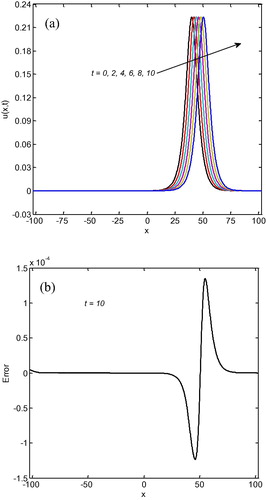
Figure 2 (a) Motion of the single solitary wave at different values of t, and (b) error distributions at with
and
.
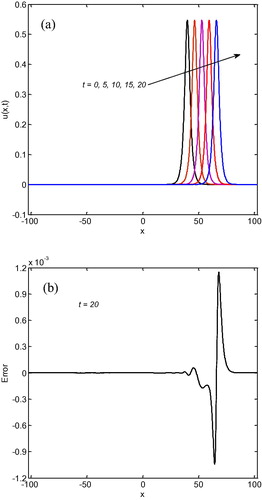
Table 1 Invariants and error norms for the single soliton with ,
,
and
.
Table 2 Invariants and error norms for the single soliton with at different values of N at t = 10 and comparison with different methods.
Table 3 Invariants and error norms for the single soliton with ,
,
and
.
Table 4 Invariants and error norms for the single soliton with at different values of N at t = 10 and comparison with different methods.
3.2 Application 2: interaction of two solitary waves
Secondly, the interaction of two positive solitary waves is studied by using the initial condition given by the linear sum of two separate solitary waves of various amplitudes,(3.24) where
,
and
(
) are arbitrary constants. The analytical values for the conservation laws in this case have the following form:
(3.25) In this case study, parameters are taken as
,
,
,
,
,
and
. These parameters provide solitary waves of magnitudes about 2 and 1 at
and their peaks are positioned at
and
. The initial function was placed with the larger wave to the left of the smaller one as seen in the a. Both waves move to the right with velocities dependent upon their magnitudes. According to , the larger wave catches up with the smaller wave at about
, the overlapping process continues until
, then two solitary waves emerge from the interaction and resume their former shapes and amplitudes. At
, the magnitude of the smaller wave is 0.996049 on reaching position
, and of the larger wave 1.999735 having the position
, so that the difference in amplitudes is 0.003951 for the smaller wave and 0.000265 for the larger wave. The analytic invariants are
,
and
. displays the values of the invariants obtained by the present method. It is observed that the obtained values of the invariants remain almost constant during the computer run and close to analytic values.
Table 5 Invariants for interaction of two solitary waves at different times.
3.3 Application 3: interaction of three solitary waves
In this section, the interaction of three solitary waves is studied with the initial conditions given by a linear sum of three separate solitary waves of various amplitudes:(3.26) where
,
and
(
) are arbitrary constant. The analytical values for the conservation laws in this case have the following form:
(3.27) In this case, parameters are chosen as
,
,
,
,
,
,
,
and
. Solitary wave having the largest amplitude is located to the left of the smaller ones. As is well known, solitary waves with larger amplitudes have a greater velocity than those with smaller amplitudes. Consequently, as time goes on the larger two solitary waves catch up with the smaller one, the overlapping process of the three solitary waves continues while the larger solitary waves have overtaken the smaller ones. Plot of the three solitary waves is depicted at various times in . At
, the amplitudes of the smaller waves are 0.481476 at the point
and 1.014965 at the point
, whereas the amplitude of the larger one is 1.997794 at the point
, so that the difference in amplitudes is 0.018524, 0.014965 and 0.002206. The analytic invariants are
,
and
. displays the values of the invariants obtained by the present method. It is observed that the obtained values of the invariants remain almost constant during the computer run and close to analytic values.
Table 6 Invariants for interaction of three solitary waves at different times.
3.4 Application 4: the Maxwellian initial condition
Finally, the evolution of solitary waves is studied by using the Maxwellian initial condition(3.28) with boundary condition
(3.29) As it is known, Maxwellian initial condition the behavior of the solution depends on the values of μ. We choose various values of
as
,
and
.
Calculated numerical invariants at different values of t for different values of μ are shown in and it is seen that calculated invariant values are satisfactorily constant and close to the other solutions like CitationKhalifa et al. (2008b) of invariants. The development of the Maxwellian initial condition is shown in with different values of μ, respectively. The smaller there is, the more the number of solitary waves will form. For
, it is observed that a single solitary wave is occurred, however, as the value of μ is reduced then the number of wave increases.
Table 7 Invariants for Maxwellian initial condition at different values of μ.
4 Conclusion
The combination between Fourier spectral method and leap frog method has been applied to obtain the numerical solution of the modified regularized long wave equation (MRLW). The accuracy, efficiency and the simplicity of the present scheme were verified by four numerical applications: the motion of a single solitary wave and its accuracy was shown by calculating error norms L2 and L∞, the interaction of two solitary waves, the interaction of three solitary waves, and development of the Maxwellian initial condition pulse is then studied at different values of μ. This scheme numerically satisfies the conservation laws of mass, momentum, and energy. The obtained results show that the present method is a remarkably successful numerical method and efficiently applied to MRLW and other types of non-linear partial differential problems.
Notes
Peer review under responsibility of University of Bahrain.
References
- A.AtanganaA.H.ClootStability and convergence of the space fractional variable-order Schrödinger equationAdv. Differ. Equ.2013201380
- A.AtanganaOn the new fractional derivative and application to nonlinear Fishers reaction diffusion equationAppl. Math. Comput.2732016948956
- T.AchouriK.OmraniApplication of the homotopy perturbation method to the modified regularized long-wave equationNumer. Methods Partial Differ. Equ.262201039941110.1002/num.20441
- T.B.BenjaminJ.L.BonaJ.J.MahonyModel equations for long waves in nonlinear dispersive systemsPhilos. Trans. R. Soc. London A272122019724778
- H.BorlukG.M.MusluA Fourier pseudospectral method for a generalized improved Boussinesq equationNumer. Methods Partial Differ. Equ.3120159951008
- Y.DereliNumerical solutions of the MRLW equation using meshless kernel based method of linesInt. J. Nonlinear Sci.13120122838
- M.M.El-BoraiH.M.El-OwaidyH.M.AhmedA.H.ArnousSoliton solutions of the nonlinear Schrödinger equation by three integration schemesNonlinear Sci. Lett. A8120173240
- B.FornbergG.B.WhithamA numerical and theoretical study of certain nonlinear wave phenomenaPhilos. Trans. Soc. London2891987373404
- B.FornbergA Practical Guide to Pseudospectral Methods1996Cambridge University PressNew York
- D.A.HammadM.S.El-AzabA 2N order compact finite difference method for solving the generalized regularized long wave (GRLW) equationAppl. Math. Comput.2532015248261
- H.N.HassanH.K.SalehThe solution of the regularized long wave equation using the fourier leap-frog methodZ. Naturforsch.65a2010268276
- H.N.HassanNumerical solution of a Boussinesq type equation using Fourier spectral methodsZ. Naturforsch.65a2010305314
- H.N.HassanH.K.SalehFourier spectral methods for solving some nonlinear partial differential equationsInt. J. Open Prob. Comput. Sci. Math.622013144179
- H.N.HassanAn accurate numerical solution for the modified equal width wave equation using the Fourier pseudo-spectral methodJ. Appl. Math. Phys.4201610541067
- M.M.HosseiniH.GhaneaiSyed TauseefMohyud-DinMuhammadUsmanTri-prong scheme for regularized long wave equationJ. Assoc. Arab Univ. Basic Appl. Sci.2020166877
- Y.GaoL.MeiMixed Galerkin finite element methods for modified regularized long wave equationAppl. Math. Comput.2582015267281
- L.R.T.GardnerG.A.GardnerF.A.IrkN.K.AmeinApproximations of solitary waves of the MRLW equation by B-spline finite elementsArab. J. Sci. Eng. A2221997183193
- D.KayaA numerical simulation of solitary-wave solutions of the generalized regularized long-wave equationAppl. Math. Comput.14932004833841
- A.K.KhalifaK.R.RaslanH.M.AlzubaidiA finite difference scheme for the MRLW and solitary wave interactionsAppl. Math. Comput.18912007346354
- A.K.KhalifaK.R.RaslanH.M.AlzubaidiNumerical study using ADM for the modified regularized long wave equationAppl. Math. Model.3212200829622972
- A.K.KhalifaK.R.RaslanH.M.AlzubaidiA collocation method with cubic B-splines for solving the MRLW equationJ. Comput. Appl. Math.21222008406418
- M.LabidiK.OmraniNumerical simulation of the modified regularized long wave equation by He’s variational iteration methodNumer. Methods Partial Differ. Equ.2722011478489
- J.LinZ.XieJ.ZhouHigh-order compact difference scheme for the regularized long wave equationCommun. Numer. Methods Eng.2322007135156
- Y.LiuH.LiY.DuJ.WangExplicit multistep mixed finite element method for RLW equationAbstr. Appl. Anal.2013201312 Article ID 768976
- L.MeiY.ChenExplicit multistep method for the numerical solution of RLW equationAppl. Math. Comput.21818201295479554
- L.MeiY.GaoZ.ChenA Galerkin finite element method for numerical solutions of the modified regularized long wave equationAbstr. Appl. Anal.2014201411 Article ID 438289
- M.MohammadiR.MokhtariSolving the generalized regularized long wave equation on the basis of a reproducing kernel spaceJ. Comput. Appl. Math.23514201140034014
- D.H.PeregrineCalculations of the development of an undular boreJ. Fluid Mech.2521966321330
- K.R.RaslanS.M.HassanSolitary waves for the MRLW equationAppl. Math. Lett.2272009984989
- K.R.RaslanT.S.EL-DanafSolitary waves solutions of the MRLW equation using quintic B-splinesJ. King Saud Univ.: Sci.2232010161166
- T.RoshanA Petrov–Galerkin method for solving the generalized regularized long wave (GRLW) equationComput. Math. Appl.6352012943956
- B.SakaI.DagA numerical solution of the RLW equation by Galerkin method using quartic B-splinesCommun. Numer. Methods Eng. Biomed. Appl.2411200813391361
- M.S.SemaryH.N.HassanAn effective approach for solving MHD viscous flow due to a shrinking sheetAppl. Math. Inf. Sci.104201614251432
- A.A.SolimanK.R.RaslanCollocation method using quadratic B-spline for the RLW equationInt. J. Comput. Math.7832001399412
- H.ZeybekS.B.G.KarakoçA numerical investigation of the GRLW equation using lumped Galerkin approach with cubic B-splineSpringerPlus51992016117

